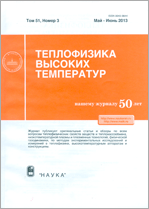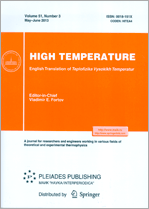|
|
Teplofizika vysokikh temperatur, 2002, Volume 40, Issue 3, Pages 388–394
(Mi tvt1796)
|
 |
|
 |
This article is cited in 1 scientific paper (total in 1 paper)
Thermophysical Properties of Materials
The Tricritical Point
I. I. Novikov
A. Baikov Institute of Metallurgy and Materials Science, Russian Academy of Sciences
Abstract:
Analysis of critical phenomena in bodies with the tricritical point, based on the Gibbs equations for the critical state, is performed. The generalized Gibbs equations allow for the difference in the symmetry of the phases, which is characteristic of bodies with the tricritical point. Successive analysis enables one to clarify all characteristics of the critical state of the class of bodies being treated, whose singularity is that their phase diagram contains regions of phase transitions of both the first and second kind, and to establish the regularity of variation of the properties in the vicinity of the tricritical point. In particular, it is demonstrated that the specific heat $C_V$ goes to infinity at the tricritical point following the logarithmic law (along the critical isochore), and the sound velocity vanishes. In the regions of phase transitions of the second kind, the specific heat $C_p$ reaches an infinitely high value at the transition point $T_c$ at $p = \text{const}$ also following the logarithmic law. The line of phase equilibrium is a cubic parabola. In the critical state, the second variation of the internal energy $\delta_2E(S$, $V)$ is zero; and, in the vicinity of the line of phase transitions of the second kind, it varies as $(T - T_c)^2$. In the critical state, the heat conductivity goes to infinity, etc.
Received: 17.07.2001
Citation:
I. I. Novikov, “The Tricritical Point”, TVT, 40:3 (2002), 388–394; High Temperature, 40:3 (2002), 352–358
Linking options:
https://www.mathnet.ru/eng/tvt1796 https://www.mathnet.ru/eng/tvt/v40/i3/p388
|


| Statistics & downloads: |
| Abstract page: | 235 | | Full-text PDF : | 149 |
|





 Contact us:
Contact us: Terms of Use
Terms of Use
 Registration to the website
Registration to the website Logotypes
Logotypes








 Citation in format
Citation in format 
